The HTC 10 Review
by Joshua Ho on September 19, 2016 8:00 AM ESTLatency with Google WALT
One of the major points of differentiation with the HTC 10 is supposed to be smoothness. This, more than anything was something that HTC emphasized repeatedly in their initial introduction of the HTC 10. This phone is supposed to be smooth in a way that most of the Android competition isn’t. It’s really kind of disappointing to me that there isn’t a lot of information in the public domain testing HTC’s claims.
So in the interest of testing this out, I managed to get a WALT device working. What's WALT, you may ask? It's an internally developed Google toolset and hardware device combination to measure touch latency on Android (and Chromebook) products. By combining some simple external sensors connected to a Teensy board with the appropriate software to measure those sensors, WALT makes it possible to directly measure several forms of touch and audio latency of an Android device. Normally this would require a high-speed camera, but Google has developed WALT as a more practical alternative, internally validatating the product against said high speed footage.
To start we can look at tap latency and screen response time. Combining these two figures together will give us the total time it takes at minimum for the device to respond to a tap. It’s worth noting here that there is an upper bound to screen response time because devices are generally locked to 60 Hz and triple buffering means that our response time at best can be 48 ms. The screen response time figure is dominated by this latency in almost all cases, with some extra overhead for the panel’s native response time and some OS overhead can be involved as well.
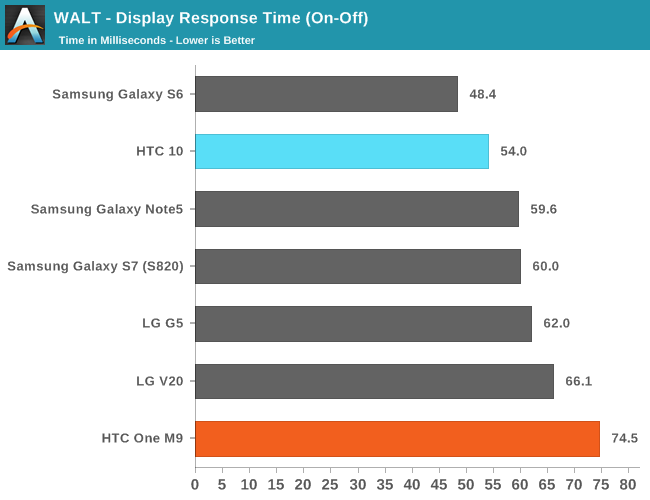
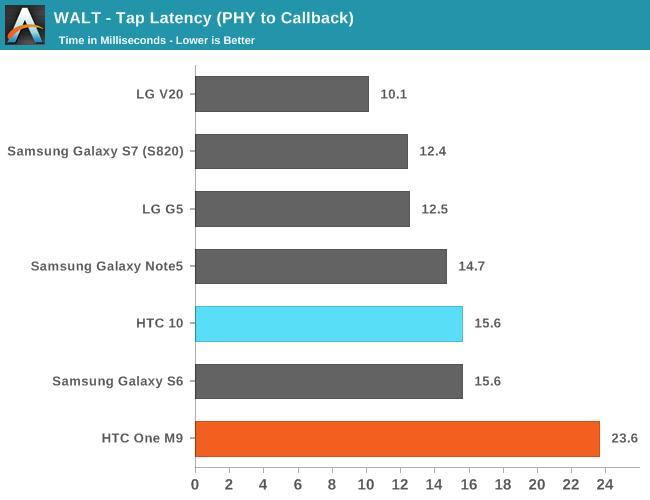
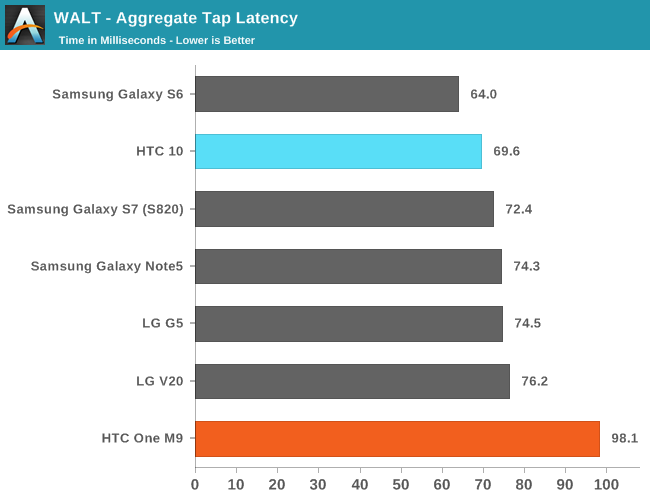
In tap latency the HTC 10 performs fairly well but everything is so close here that I'm not sure it really matters. In the interest of trying to see what exactly HTC was trying to highlight I also went ahead and used the drag latency test to try and see if this was a notable point of differentiation.
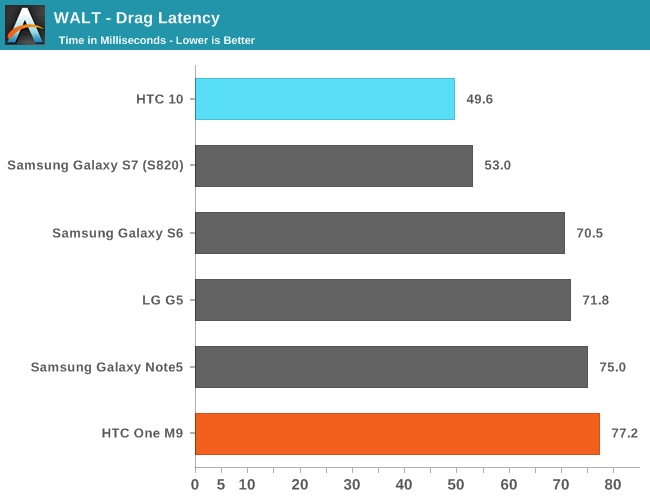
While I would say that WALT's drag latency test seems to be highly unreliable and I'm kind of questionable on whether these results can really be trusted, there's definitely a noticeable difference in how quickly the HTC 10 responds to a swipe compared to most of the competition. The Galaxy S7 seems to keep up which is kind of surprising. I suspect that most of the difference in response between the two devices is the momentum given to a swipe rather than the actual latency.
Misc
With every review there are a lot of little things here and there that I end up discovering along the way that are interesting and worth discussing, but often cannot be discussed in a section of its own, but there are definitely things that have managed to grow past this section into their own as noteworthy.
One of the first places to start is the GNSS of this phone. I’m not sure what exactly HTC did here, but it’s remarkably fast and high quality. When connected to a network A-GPS through the cellular modem (Qualcomm gpsOne) allows for near-instant locks, but I managed to achieve a true cold lock in 1 minute and 6 seconds and it reached a precision of 13 feet within 10 seconds after initial position fix. Precision seems to be as high as 10 feet, which is pretty much the lower bound of what GPS can do without differential GPS systems which allow for precision down to about 10 centimeters.
In addition to GPS reception for whatever reason the HTC 10 seems to have noticeably good reception on AT&T LTE in the SF Bay Area and Los Angeles. It was not unusual for me to see the One M7 sitting on HSPA+ while the HTC 10 would still be on LTE. Of course, I don’t have any formal testing to back this claim up but generally speaking I saw anywhere from 3 to 6 dBm of difference in received power in favor of the HTC 10.
As far as design wins go, ST-M takes the design win for the laser auto-focus sensor, Synaptics is used for the touchscreen, Cypress CapSense Cy8C PSoC is used for the capacitive buttons, an NXP TFA9888 amp is used for the speakers, NXP PN544 is used for NFC, and an Analogix chip is used to enable the USB-C port. It’s identified only by the codename Ohio, but it’s fairly likely that this is the ANX7418. There’s also an ANX7816 for 4K30 over SlimPort. Looking at the SPI bus, for some reason there’s a Micrel KS8851 Ethernet MAC controller and HTC’s custom MCU which is referred to as CwMcuSensor. There’s also an Fingerprints FPC1155 for the fingerprint scanner, and an AK8789 hall sensor.
HTC claims that audio is over a separate DAC and amp, but I really can’t find any evidence that the HTC 10 has a DAC outside of the Snapdragon 820 in the system files, namely the WCD9335. Regardless, the speakers on the HTC 10 are a lot better than most other Android phones on the market. They’re still a step down from the One M9 or M8, but they do provide a fairly convincing stereo effect if you turn it on and overall quality is acceptable. I’m not exactly an audiophile but music over the 3.5mm jack didn’t have any noticeable issues like hissing or popping or anything strange like that.


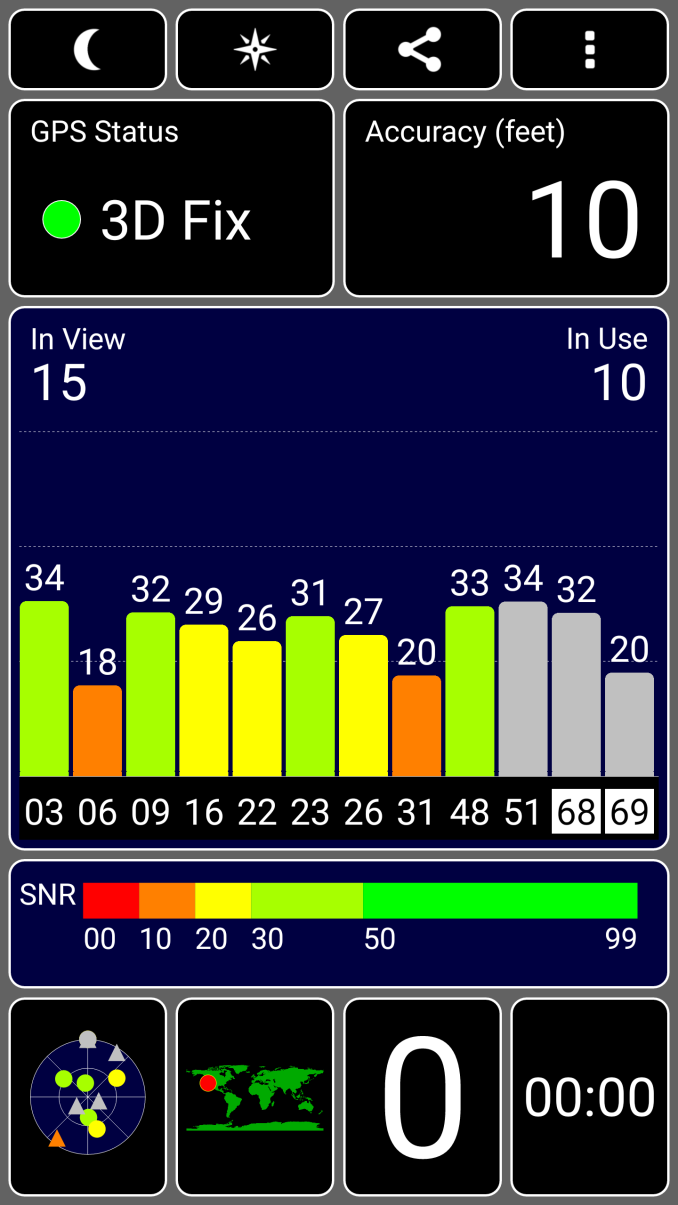








183 Comments
View All Comments
kmmatney - Monday, September 19, 2016 - link
Sounds like my experience a few years ago. I switched to a "high end" LG phone because I got tired of Apple not having larger screens. I loved it at first, but had a lot of the same issues - keyboard didn't work well, battery life sucked, and other annoying issues. Tried a few different ROMs (everyone seemed to have their favorites that was the "best" one), but that just made things worse - would fix a particular issue, but create several others. Stuck it out for 18 months, and then finally just sold it, took a $50 hit (hey, I'm cheap!), and bought a used iPhone 5 to tide me over for 6 months until next upgrade cycle. I guess it was all "user error" on my part.fanofanand - Tuesday, September 20, 2016 - link
You are absolutely right, expecting your SOT to match the "call time" numbers is totally normal. /sMorawka - Monday, September 19, 2016 - link
if this review is getting this many comments then HTC is doing something right here.StrangerGuy - Monday, September 19, 2016 - link
Yeah they doing a great job if market success is solely determined by how much comments the vocal tiny minority generates.Oh and BTW I'm sick of hearing trite being called "innovation" at every single corner. That buzzword is so debased to the point of uselessness.
JKJK - Monday, September 19, 2016 - link
Long time htc fan. Ordered one this weekend + a 200GB SD card.Good review, even thought it's a bit late. But finding bugs like wifi and such that MIGHT give it enought focus to make HTC look into it, is worth it. Even tought it has a few sore spots, I suppose it will be a nice upgrade from my M9 either way.
A friend of mine has one, and one thing I really don't like about it, is that is a bit unergonomic when you have small hands, like I do. And the edge on the back makes it uncomfortable to hold compared to the M9 because of this (edge).
JKJK - Monday, September 19, 2016 - link
Another weird thing ... It doesn't seem possible to find original norwegian / european charger for the HTC 10. I'm speaking of the Rapid charge / Quick Charge 3.0 with USB Type C. You actually have to buy another phone (!) at this point to get a charger. For now, I'm stuck with the M9's rapid charger / Quick charge 2.0 adapter and a belkin USB C cable. Very frustrating.It took almost a year before a Quick Charge 2.0 charger hit the market for the for the M9, and it hit england about 3 months before norway. According to Scandinavian (swedish) support, It's supposed to hit market "within 2016". Not good.
Vagabondjonez - Tuesday, September 20, 2016 - link
thats harsh man. I have so many qc 2 adapters lolfanofanand - Tuesday, September 20, 2016 - link
Google "Anker" they make fantastic QC 3.0 with Type C bases.JKJK - Tuesday, September 20, 2016 - link
Yes, but not with norwegian/european plugs?However. Found another qualcom certified qc3 chargers with europlug and usbc.
Compared with some high quality belkin cables with 3A suport and correct resistance, I think I'm gettig there.
I think it wad Aukey/Auky chargers
JKJK - Tuesday, September 20, 2016 - link
Err.. paired with the belkin cables.However. Original htc qc3 charger is said to be coming in sale this year (Htc tc p5000-eu/uk/etc.)